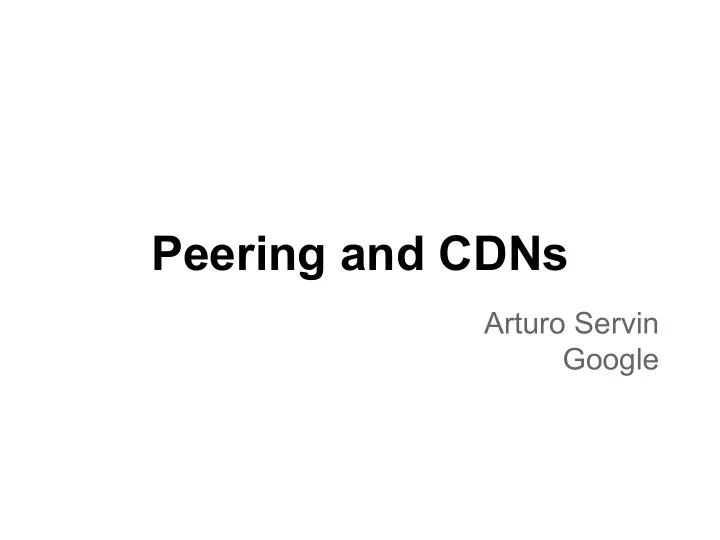

Peering and CDNs Arturo Servin Google
Imagine you’re a Content Provider Content Provider
Imagine you’re a Content Provider User ISP Content Provider
Imagine you’re a Content Provider User Transit ISP Provider Content Provider
Imagine you’re a Content Provider User Transit ISP Provider Content Provider User Transit ISP Provider
If you are very successful ... User Transit ISP Provider Content Provider User Transit ISP Provider
Peering User Transit ISP Provider Content Provider User Transit ISP Provider
Peering ● Peering is the direct interconnection between two networks for the exchange of traffic.
Peering User IXP or ISP Colo Facility Content Provider User ISP
Public Peering ● Public Peering ○ Done in Internet Exchange Points ○ Better when traffic is low to many individual peers and aggregation of traffic creates an economical incentive
Public Peering - IXP User ISP L2 Switch Content Provider User ISP
IXP governance models ● Private vs non-profit ● Membership-based vs other ● Government sponsored/operated vs non-gov. spon./oper. ● Closed vs. Open
What about too much traffic to just a few peers in the IXP? User ISP L2 Switch Content Provider User ISP
Private Peering ● Private Peering ○ Done in private links or in carrier houses ○ Better control of traffic flows ○ Better when individual traffic is high
Private Peering ISP 1 ISP 2 Content Provider
Private Peering in colo facility Meet Me Room / Patch User panel ISP User Content Provider ISP
Private Peering in colo facility Meet Me Room / Patch User panel ISP User Content Provider ISP cross-connection
Private peering vs Public Peering ● Both are good solutions aimed to different needs ● Small-medium ISPs/Content providers generally use more Public Peering ● Very large ISPs/Content providers generally use more private peering to other large peers and public to small-medium
The next step to scale and grow your content ... Content Distribution Network (CDN)
What is a CDN (Content Delivery Network)? Source ● Distributed delivery platform for content Content Network ● Servers content closer to end-users ● Improve performance for users Transit Network ● Lower cost for content and access provider Eyeball Network Eyeball Network CDN CDN
Example of CDNs ● Traditional and Telco CDNs ○ Akamai ○ Cloudflare ○ Level3 ○ Limelight Networks ● Content Provider own CDNs ○ Google ○ Netflix
Benefits of Peering & CDN relationships ● For users: ○ Lower latency ○ Higher reliability ○ Better performance ● For network operators: ○ Lower costs ○ Higher reliability ○ More predictable routing ○ Better performance for customers ○ No third parties involved ○ Mutually beneficial relationship with partner
El caso de negocio del Peering ● ¿Cómo convencer al CFO de hacer peering? ● No hablar sobre BGP, routing, mejora de latencia, etc., etc. ● Haz un análisis de Costo-Beneficio
Análisis Costo-Beneficio Comparación Costo Monetario Transporte al Fijo a cierta Transito En base a uso punto de peering capacidad Colocación Fijo Equipmiento Fijo Costo de Puerto Fijo en IXP/x-connect
Comparación Costos Fuente: Dr Peering http://drpeering.net/white-papers/A-Business-Case-F or-Peering.php
El Caso de Negocio de Peering ● By Dr. Peering ○ http://drpeering.net/white-papers/A-Bu siness-Case-For-Peering.php
Assumptions ● Transit ○ Cost of transit 5 USD per Mbit per month ● Peering (10G) ○ Local transport: 2,000 USD per month (10G) ○ Colocation fee: 1,000 USD per month ○ IX port: 2,000 USD per month ○ Equipment: 8,000 USD per month (router amortized at 36 months) ○ Total: 13,000 USD total per month
Peering break even ● Break even point in BW ○ Cost of peering / Transit cost ○ (13,000 MRC) / (5 USD/Mbps/MRC) ○ = 2.6G ● Cost of peering at maximum efficiency ○ Cost of peering / BW ○ 13,000 / 10,000 ○ = 1.3 Mbps per USD per Month
Thank you and happy peering
Recommend
More recommend